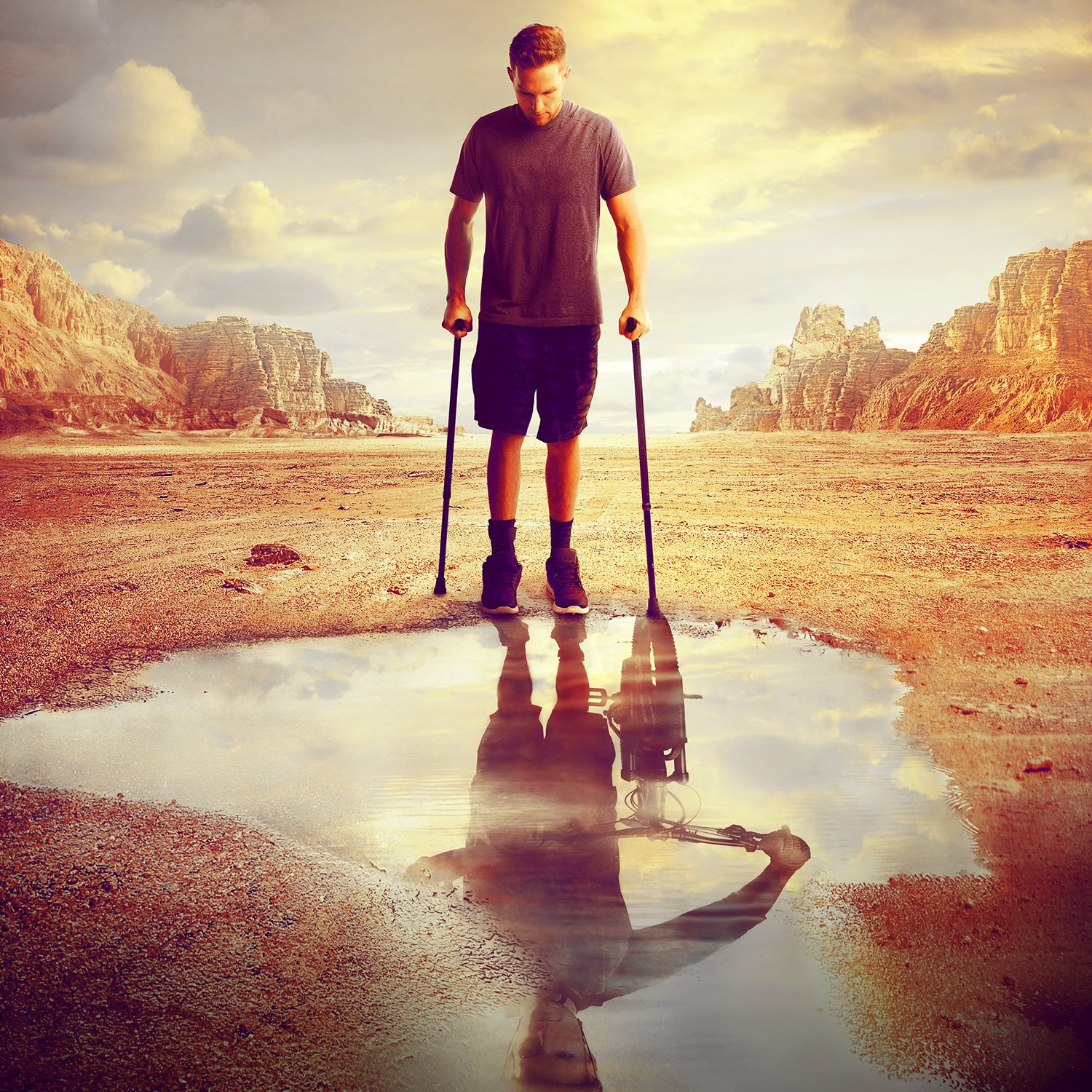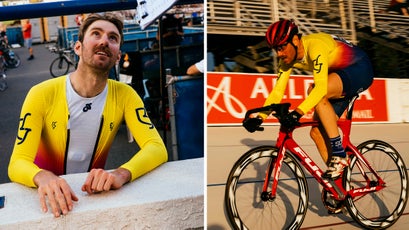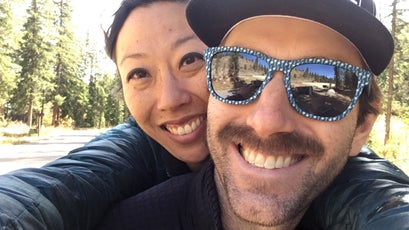The first time I watched the documentary Any One of Us was about four months before my fiancé, Andrew Bernstein, was hit by a van and very nearly killed while riding his bike.
At the time, I was working on a about professional mountain biker Paul Basagoitia, who had sustained a spinal-cord injury in 2015 at Red Bull Rampage, the sport’s most extreme competition. At the age of 29, Paul was paralyzed below the waist, and doctors gave him a 5 percent chance of walking again. Three and a half years later, I’d seen on his Instagram that he was riding an e-mountain bike. When we started talking in February, Paul told me he was releasing a film with Red Bull about his journey. The documentary, called Any One of Us, would . In February, Andrew and I watched a screener together one Friday night on the couch, my notebook in my lap, our cat curled up in his. By the end of the film, I was crying, rocked not only by Paul’s story but that of the 17 other people in the film who share their honest perspective on what it is like to live with paralysis. A few weeks after that, I went to visit Paul in Reno, Nevada. I filed a draft of my piece in April. I hoped his story would inspire people. I hoped it would remind them to be grateful for what they have, to appreciate how instantaneously it can all go away.
In July, someone driving a cargo van hit Andrew while he was riding his bike home on a country road outside Boulder, Colorado. The driver fled the scene, leaving Andrew in a ditch with over 30 broken bones (including every rib), collapsed lungs, life-threatening internal bleeding from a shattered pelvis, and—though we wouldn’t know at first—a spinal-cord injury (SCI). It would paralyze his left leg and disrupt his bowel and bladder functions. In September, after two months of intensive and acute hospitalization, Andrew ended up at Craig Hospital, the same nationally renowned SCI rehab facility in Denver that had treated Paul. We would not come home until October. Any One of Us , on October 29.
The strangeness of the parallel is undeniable. At first I felt sick thinking this could be karmic—that by making Paul revisit the most traumatic moments of his life, by capitalizing (even with good intentions) on his ordeal, I had brought this upon us. A good friend of mine had a more optimistic take—that meeting Paul had prepared us. The most likely reality is neither: This was simply a coincidence. This could happen to you or me.
As the film’s title belies, that’s one of its main messages: a spinal-cord injury could happen to anyone. The narrative of Any One of Us follows the fallout of Paul’s injury over two years. The first half was actually filmed by Paul himself, who has some videography background and had the remarkable prescience to turn the camera on himself, almost from day one. But first-time director Fernando Villena uses a unique filmmaking technique to powerful effect: introducing what Villena calls a “chorus” of 17 other people who share their experiences with SCI throughout the documentary. At the moment of Paul’s injury, which was recorded not only by Rampage’s live broadcast but also on Paul’s own GoPro, members of the chorus chime in with their own stories of the incidents that left them in wheelchairs: Caught by a wave while surfing. Botched epidural. BMX crash. Car accident. Knocked over while playing basketball.
Villena and Basagoitia wanted the film to be bigger than the story of one professional athlete. The estimates that 17,700 people in the U.S. suffer new spinal-cord injuries every year and . The inclusion of the chorus creates the effect of describing a collective SCI experience. The wheelchair-bound individuals speak with clarity and courage about various aspects of the injury—from what happened to their sex lives, to the feeling of being “in the way” or an inconvenience to others, to their defiance at the idea that their value as a human being has somehow changed just because they’re in a wheelchair. “I hated my fiancée seeing me,” says Olympic BMX racer Sam Willoughby.
“I wanted to die. I didn’t see how I could continue living like that. Or like this,” says Steph Aiello, who was injured in a car accident.
Basagoitia himself reveals, “Before this injury, I always said I would probably take my life if I was ever paralyzed.” It’s a sentiment that, even watching the film the first time, hit home. Particularly for active people, the idea of waking up paralyzed is, to borrow Paul’s word, a nightmare. Paul had been one of the best professional slopestyle and freeride mountain bikers in the world. At age 17, he entered the inaugural edition of Crankworx, now the world’s premier slopestyle competition, on a lark, riding a borrowed bike. Against the best pros in the world, he won. The next year, he won again. Scenes from his recovery, as he relearns how to do basic things like transfer into a car from his wheelchair and walk haltingly on parallel bars, are juxtaposed with scenes from his career: Paul spinning in the air, doing a 360; Paul spraying himself with champagne on the podium; Paul shirtless, hanging jubilantly out of the driver’s seat of a trophy truck he won in Germany (he’d sell it the next day: “There was no way I was getting that thing back to the U.S.,” he laughed, when he told me the story in Reno).
In the hospital, I thought of Paul as I watched my fiancé struggle with stairs for the first time after his injury, leaning on a handrail and laboriously placing his left leg, stiff and heavy in its metal brace, on each step. Andrew and I are both cyclists. We rode our bikes five to seven days a week. An elite-level track and road racer, Andrew had always been one of the strongest guys on the group ride. When I was tired, I would sit in the generous draft forged by his six-foot-three frame, and he would pull me home. In the early days in the ICU, when we knew about his injury but he was too delirious and doped up on pain medications to yet be told, he had still somehow known. One night, after his brother, Eric, and I left the hospital, he texted us, “Remember, I used to be a good bike racer.”
I wanted to scream.
In Reno, Paul’s then girlfriend and now fiancée, Nichole Munk, had told me that she did not cry throughout the three months that Paul was in hospitals. If that sounds unbelievable to you, it won’t be once you watch the film, throughout which it becomes apparent that Nichole is an extraordinary human being and one uncannily equipped to support Paul through his ordeal. There’s a moment in particular in Any One of Us that Paul and Nichole told me got a lot of surprised reactions from people during screenings: After a visit from his father in the hospital, Paul gets emotional and starts choking up as he talks about it. Instead of cooing over him, Nichole tells him to “toughen up.”
It’s a jarring interaction and one that flies in the face of our preconceptions of how women are supposed to be caretakers: soft and endlessly nurturing. And yet, a few minutes later, Nichole—who started dating Paul while she was cheerleading for the University of Nevada, Reno—is dancing in his wheelchair, laughing, an infectious smile on her face. And he’s laughing, too. “I have to be positive so he can be happy,” she says in a voice-over. “I have to be the rock.” Munk does not embody the performative sympathy we think someone in that position might want; she is the constant source of no-bullshit straight talk, relentless positivity, and unshakable love that Paul Basagoitia actually needs. A year later, as the two of them argue over whether he should try fetal-stem-cell therapy, Nichole tells him, “You’re not a very pleasant person to be around right now.” They offer a real, unvarnished look at what it takes to be a partner and caregiver during this kind of life-altering ordeal.
Particularly for active people, the idea of waking up paralyzed is, to borrow Paul’s word, a nightmare.
Andrew’s injury has become the sun around which we orbit. It has its own gravitational pull, which overpowers that of the minor planets our lives used to revolve around: our bikes, our careers, our friends, our families. After July 20, life became a sleep-deprived blur of commuting up and down a traffic-choked interstate, days and nights spent in hospitals, and, once I went back to work, struggling to reintegrate into a new job I’d just started three weeks before his crash. It was, plainly put, exhausting. I could sense, on a few occasions, that when friends and family dropped in on us, they thought I could be more doting—nicer, more attentive, fussing over him more. But as Andrew has gotten more self-sufficient—he spends most of his day in a wheelchair but can walk short distances on forearm crutches—he doesn’t need someone to hover over him or shield him from the hard emotional work of making the best of this shitty situation. He needs someone to scrape the snow off his car early in the morning so he can get to PT, to carry the bags back in from the grocery store, and to call him out or make him smile or do both at the same time so he can self-arrest during the inevitable slides into darkness. He doesn’t need a nurse. He needs a partner.
Since Andrew’s injury, I have thought of Nichole Munk often. In my mind, she’s an example of what it means to be the support someone needs, not just the support everyone expects you to be. We should all hope to have and be the kind of partner she is.
At its core, this movie is an instructional. But for whom? The genre of disability stories too easily falls into the trap of inspiration porn for an able-bodied audience. But from the first clips Paul took in the hospital, Any One of Us didn’t begin as a documentary for the rest of us. In a way, it often feels like a conversation between people living with an SCI. We are allowed in to listen, watch, and learn.
When Basagoitia started filming himself, he told me, he didn’t know what he was going to do with the footage. He just had the sense that his experience might one day help others going through the same thing. As early as the day he got his staples out from his back surgery, a couple of weeks after his crash, he said into the camera, “I just hope this can be a guide for someone else.” One of the most challenging aspects of a spinal-cord injury is uncertainty. The delicate bundle of nerve fibers that carries messages from your brain to the rest of your body, and which also regulates sensory, motor, and autonomic function, is highly susceptible to damage and heals slowly once injured, if at all. Most recovery takes place within 18 months to two years, but the neurological recovery of every person is different, and it is impossible to know what you’ll regain.
When Paul began collaborating with Villena and Red Bull, the intentions for the film became twofold—to be a field manual for people living with an SCI and to raise awareness about their experience. Awareness leads to interest, which leads to funding for a cure—which doesn’t currently exist for spinal-cord injuries, though some experimental therapies have shown promise. Until now, awareness has been critically lacking, Basagoitia told me in Reno. Since the late actor Christopher Reeve, who suffered an SCI while horseback riding, passed in 2004, the popular media has largely overlooked it. Any One of Us was just one of two feature-length documentaries I could find online about the topic. (The other was , released in 2018.)
Basagoitia holds nothing back in educating viewers about the reality of an SCI. One of the rawest scenes of the film shows Paul nude in front of the hospital toilet in the middle of the night, inserting a catheter to urinate. It takes him over seven minutes. There is footage of Nichole helping him bathe. It’s a searingly honest look into what people with an SCI endure on a daily basis. But it must also be said that both Paul and Andrew were relatively fortunate; both were paralyzed below the waist, with incomplete injuries—their cords were not totally severed. Those with complete injuries face a life of paralysis with little hope of significant recovery. At Craig Hospital, Andrew and I also interacted with quadriplegic patients, some of whom were learning to control powered wheelchairs using their breath. In one scene, after he arrives at Craig, Paul tells the camera somberly, “There’s not one person here at the hospital who isn’t in a wheelchair. In fact, there’s a lot of people who are in worse situations.”
As the film follows Paul through his recovery, the viewer comes to relate with the experience of finding triumph in the smallest victories—a feeling Andrew and I have come to know well. He would text me to tell me a new muscle strand had started twitching or that he had stood for a full 30 seconds on his own. But there are big wins, too. Villena selected an impressive group to represent the chorus: author Annette Ross, after her injury; Chelsie Hill, who started a wheelchair dance team; Jesse Billauer, who became the adaptive world champion of surfing in 2015. As for Paul, he makes his way back onto the bike about a year after his injury. His first ride is captured on film, and his pure joy is palpable.
These moments, which are paired with a stirring but not overly melodramatic soundtrack, are emotional, but it’s more than voyeuristic inspiration. It’s a shared sense of triumph that’s earned after bearing witness to the hardships of this injury. And for anyone living with an SCI, the scenes of those in the chorus walking, playing basketball, dancing, and riding a bike again are a powerful promise that your best days can still lie before you.
Perhaps that is one of the greatest accomplishments of this film, that it manages to speak to both audiences. Andrew and I know this because we’ve seen the film twice. The first time, we were deeply affected by the experience and determination of this community. We learned that, with resolve, life in a wheelchair could in fact be richer and more beautiful than life before it. We saw that it’s a defect, a bug coded into our human nature, that we never know how to truly appreciate what we have until we lose it.
The second time we watched the film, two weeks before it aired on HBO and three months after our own SCI journey began, we were searching for the common threads between our story and those of others who had been through it before. This time we were hunting for clues that would show us the way forward. We cried when we saw them over and over.
Paul Basagoitia wanted to be a guide for how to beat a spinal-cord injury. With Any One of Us, he ended up creating a guide for how to live. This film is more than an inspirational story. It is a testimony. It is a map through hell. It is a gift of hope.





